Students can Download Bio Botany Chapter 3 Chromosomal Basis of Inheritance Questions and Answers, Notes Pdf, Samacheer Kalvi 12th Bio Botany Book Solutions Guide Pdf helps you to revise the complete Tamilnadu State Board New Syllabus and score more marks in your examinations.
Tamilnadu Samacheer Kalvi 12th Bio Botany Solutions Chapter 3 Chromosomal Basis of Inheritance
Samacheer Kalvi 12th Bio Botany Chromosomal Basis of Inheritance Text Book Back Questions and Answers
Question 1.
An allohexaploidy contains ___________
(a) Six different genomes
(b) Six copies of three different genomes
(c) Two copies of three different genomes
(d) Six copies of one genome
Answer:
(b) Six copies of three different genomes
Question 2.
The A and B genes are 10 cM apart on a chromosome. If an AB/ab heterozygote is testcrossed to ab/ab, how many of each progeny class would you expect out of 100 total progeny?
(a) 25 AB, 25 ab, 25 Ab, 25 aB
(b) 10AB, 10ab
(c) 45 AB, 45 ab
(d) 45 AB, 45 ab, 5 Ab, 5aB
Answer:
(b) 10AB, 10ab
Question 3.
Match list I with list II
| List I | List II |
| A. A pair of chromosomes extra with diploid | (i) monosomy |
| B. One chromosome extra to the diploid | (ii) tetrasomy |
| C. One chromosome loses from diploid | (iii) trisomy |
| D. Two individual chromosomes lose from diploid | (iv) double monosomy |
(a) A-i, B-iii, C-ii, D-iv
(b) A-ii, B-iii, C-iv, D-i
(c) A-ii, B-iii, C-i, D-iv
(d) A -iii, B-ii, C-i, D-iv
Answer:
(c) A-ii, B-iii, C-i, D-iv
Question 4.
Which of the following sentences are correct?
1. The offspring exhibit only parental combinations due to incomplete linkage
2. The linked genes exhibit some crossing over in complete linkage
3. The separation of two linked genes are possible in incomplete linkage
4. grossing over is absent in complete linkage
(a) 1 and 2
(b) 2 and 3
(c) 3 and 4
(d) 1 and 4
Answer:
(c) 3 and 4
![]()
Question 5.
Accurate mapping of genes can be done by three-point test cross because increases ___________
(a) Possibility of single cross over
(b) Possibility of double cross over
(c) Possibility of multiple crosses over
(d) Possibility of recombination frequency
Answer:
(b) Possibility of double cross over
Question 6.
Due to incomplete linkage in maize, the ratio of parental and recombinants are ___________
(a) 50 : 50
(b) 7 : 1 : 1 : 7
(c) 96.4 : 3.6
(d) 1 : 7 : 7 : 1
Answer:
(b) 7 : 1 : 1 : 7
Question 7.
Genes G S L H are located on the same chromosome. The recombination percentage is between and G is 15%, S and L is 50% and H and S are 20%. The correct order of genes is ___________
(a) GHSL
(b) SHGL
(c) SGHL
(d) HSLG
Answer:
(b) SHGL
Question 8.
The point mutation sequence for transition, transition, transversion, and transversion in DNA are ________
(a) A to T, T to A, C to G and G to C
(b) A to G, C to T, C to G and T to A
(c) C to G, A to G, T to A and G to A
(d) G to C, A to T, T to A and C to G
Answer:
(b) A to G, C to T, C to G and T to A
Question 9.
If the haploid number in a cell is 18. The double monosomic and trisomic number will be ___________
(a) 35 and 37
(b) 34 and 37
(c) 37 and 35
(d) 17 and 19
Answer:
(b) 34 and 37
Question 10.
Changing the codon AGC to AGA represents ___________
(a) mis-sense mutation
(b) non-sense mutation
(c) frameshift mutation
(d) deletion mutation
Answer:
(a) mis-sense mutation
Question 11.
Assertion (A): Gamma rays are generally used to induce mutation in wheat varieties.
Reason (R): Because they carry lower energy to non-ionize electrons from an atom
(a) A is correct. R is correct explanation of A
(b) A is correct. R is not correct explanation of A
(c) A is correct. R is wrong explanation of A
(d) A and R is wrong
Answer:
(c) A is correct. R is wrong explanation of A
Question 12.
How many map units separate two alleles A and B, if the recombination frequency is 0.09?
(a) 900 cM
(b) 90 cM
(c) 9 cM
(d) 0.9 cM
Answer:
(d) 0.9 cM
Question 13.
When two different genes came from the same parent they tend to remain together.
- What is the name of this phenomenon?
- Draw the cross with a suitable example.
- Write the observed phenotypic ratio.
Answer:
(i) Linkage
(ii)
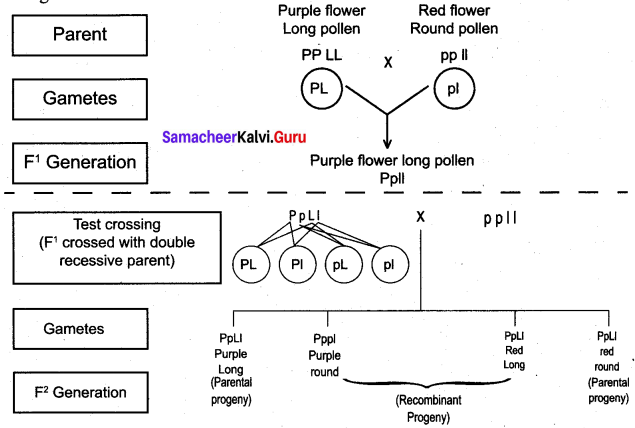
(iii) Observed Pherotypic ratio 7 : 1 : 1 : 7
Question 14.
If you cross dominant genotype PV/PV male Drosophila with double recessive female and obtain F1 hybrid. Now you cross F1 male with double recessive female.
- What type of linkage is seen?
- Draw the cross with correct genotype.
- What is the possible genotype in F2 generation?
Answer:
(i) Incomplete linkage
(ii) Parent Garnets
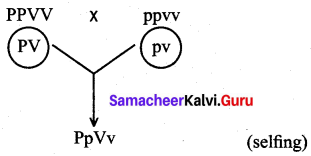
F1 hybrid

Question 15.
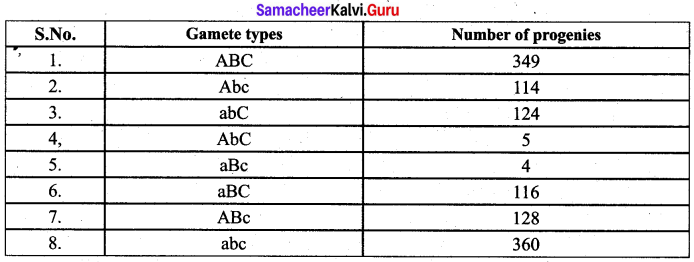
- What is the name of this test cross?
- How will you construct gene mapping from the above-given data?
- Find out the correct order of genes.
Answer:
(i) Three-point test cross.
(ii) Construction of gene map:
To construct the gene map, the recombinant frequency (RF) of the alleles has to be calculated.
From the given data it is clear that ABC and abc are parental (P) types and the others (Abe, abC, AbC, aBc, ABc) are recombinant (R) type.
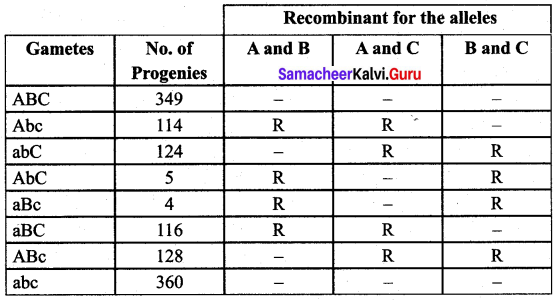
Lets analyse the loci of two alleles at a time starting with A and B. Since the genes AB and ab are parental type, the recombinants will be Ab and aB.
Therefore
Recombinant frequency of alleles Ab and aB = \(\frac { No.of recombinant }{ Total progenies }\) × 100
\(\frac { 114+5+4+116 }{ 1200 }\) × 100 = 19.91%
Recombinant frequency for the loci B and C
The parental form are Be and bC and the recombinant are Be and bC.
Recombinant frequency of alleles Be and bC = \(\frac { 4+128+124+5 }{ 1200 }\) × 100 + 21.75%
Since the recombinant frequency of the alleles A and C shown highest frequency, they must be the farthest apart and alleles B must lie in between A and C. So the gene map can be constructed as follows

(iii) The correct gene order is ABC/abc.
Question 16.
What is the difference between missense and nonsense mutation?
Answer:
Missense mutation (Non-synonymous)
- The mutation where the codon for one amino acid is changed into a codon for another amino acid.
- Change in amino acid encoded TTA→AAT (Transition)
Nonsense mutation (Termination) :
- The mutation where codon for one amino acid is changed into a termination or stop
- Creates translational termination codon (UAA, UAG, UGA)
![]()
Question 17.
A B C C B D E F G H I
From the above figure identify the type of mutation and explain it.
Answer:
In reverse tandem duplication, the duplicated segment is located immediately after the normal segment but the gene sequence other will be reversed.
Question 18.
Write the salient features of Sutton and Boveri concept.
Answer:
Sutton and Boveri (1903) independently proposed the chromosome theory of inheritance. Sutton united the knowledge of chromosomal segregation with mendelian principles and called it the chromosomal theory of inheritance.
Salient features of the chromosomal theory of inheritance
- Sometic cells of organisms are derived from the zygote by repeated cell division (mitosis).
- These consist of two identical sets of chromosomes. One set is received from female parent (maternal) and the other from male parent (Parental)
- These two chromosomes constitute the homologous pair.
- Chromosomes retain their structural uniqueness and individuality throughout the life cycle of an organism.
- Each chromosome carries specific determiners of mendalian factors which are now termed as genes.
- The behaviour of chromosomes during the gamete formation (meiosis) provides evidence to the fact that genes or factors are located on chromosomes.
Question 19.
“Explain the mechanism of crossing over.
Answer:
Crossing over is a precise process that includes stages like synapsis, tetrad formation, cross over and terminalization.
(i) Synapsis: Intimate pairing between two homologous chromosomes is initiated during zygotene stage of prophase I of meiosis I. Homologous chromosomes are aligned side by side resulting in a pair of homologous chromosomes called bivalents. This pairing phenomenon is called synapsis or syndesis. It is of three types:
- Procentric synapsis: Pairing starts from middle of the chromosome.
- Proterminal synapsis: Pairing starts from the telomeres.
- Random synapsis: Pairing may start from anywhere.
(ii) Tetrad Formation: Each homologous chromosome of a bivalent begin to form two identical sister chromatids, which remain held together by a centromere. At this stage each bivalent has four chromatids. This stage is called tetrad stage.
(iii) Cross Over: After tetrad formation, crossing over occurs in pachytene stage. The non-sister chromatids of homologous pair make a contact at one or more points. These points of contact between non¬sister chromatids of homologous chromosomes are called Chiasmata (singular-Chiasma).
At chiasma, cross-shaped or X-shaped structures are formed, where breaking and rejoining of two chromatids occur. This results in reciprocal exchange of equal and corresponding segments between them. A recent study reveals that synapsis and chiasma formation are facilitated by a highly organised structure of filaments called Synaptonemal Complex (SC). This synaptonemal complex formation is absent in some species of male Drosophila, hence crossing over does not takes place.
(iv) Terminalisation: After crossing over, chiasma starts to move towards the terminal end of chromatids. This is known as terminalisation. As a result, complete separation of homologous chromosomes occurs.
Question 20.
Write the steps involved in molecular mechanism of DNA recombination with diagram.
Answer:
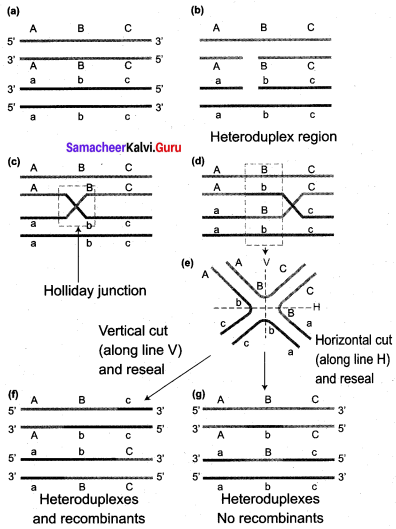
- Homologous DNA molecules are paired side by side with their duplicated copies of DNAs
- one stand place by the enzyme endonuclease.
- The cut strands cross and join the homologous strands forming the Holliday structure or Holliday junction.
- The Holliday junction migrates away from the original site, a process called branch migration, as a result heteroduplex region is formed.
- DNA strands may cut along through the vertical (V) line or horizontal (H) line.
- The vertical cut will result in heteroduplexes with recombinants.
- The horizontal cut will result in a heteroduplex with nonrecombinants.
![]()
Question 21.
How is Nicotiana exhibit self-incompatibility? Explain its mechanism.
Answer:
Self-sterility means that the pollen from a plant is unable to germinate on its own stigma and will not be able to bring about fertilization in the ovules of the same plant. East (1925) observed multiple alleles in Nicotiana which are responsible for self-incompatibility or self-sterility. The gene for self-incompatibility can be designated as S, which has allelic series S1 S2, S3, S4 and S5. The cross-fertilizing tobacco plants were not always homozygous as S1 S1 or S2 S2, but all plants were heterozygous as S1 S2, S3 S4 and S5 S6. When crosses were made between different S1 S2 plants, the pollen tube did not develop normally. But effective pollen tube development was observed when the crossing was made with other than S1S2 for example S3S4.
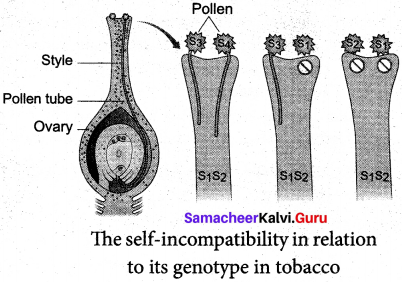
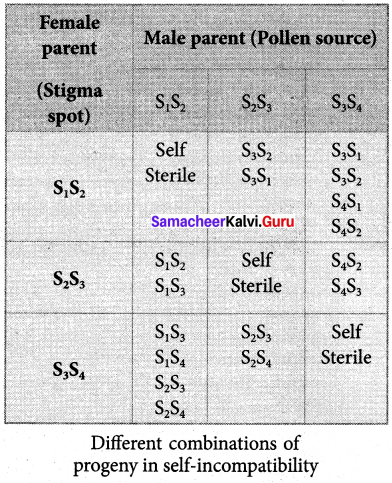
When crosses were made between seed parents with S1S2 and pollen parents with S2S3, two kinds of pollen tubes were distinguished. Pollen grains carrying S2 were not effective, but the pollen grains carrying S3 were capable of fertilization. Thus, from the cross S1 S2 X S3 S4, all the pollens were effective and four kinds of progeny resulted: S1S3, S1 S4, S2 S3 and S2 S4.
![]()
Question 22.
How sex is determined in monoecious plants? Write their genes involved in it.
Answer:
Zea mays (maize) is an example for monoecious, which means male and female flowers are present on the same plant. There are two types of inflorescence. The terminal inflorescence bears staminate florets that develop from shoot apical meristem called tassel. The lateral inflorescence which develop pistillate florets from axillary bud is called ear or cob. Unisexuality in maize occurs through the selective abortion of stamens in-ear florets and pistils in tassel florets. Substitution of two single gene pairs ‘ba’ for barren plant and ‘ts’ for tassel seed makes the difference between monoecious and dioecious (rare)
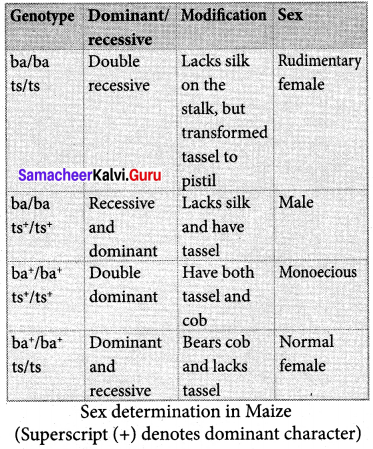
maize plants. The allele for barren plant (ba) when homozygous makes the stalk staminate by eliminating silk and ears. The allele for tassel seed
(ts) transforms tassel into a pistillate structure that produce no pollen. The table is the resultant sex expression ‘ based on the combination of these
alleles. Most of these mutations are shown to be defects in gibberellin biosynthesis. Gibberellins play an important role in the suppression of stamens in florets on the ears.
Question 23.
What is gene mapping? Write its uses.
Answer:
Definition:
Genes on present on the locus in a chromosome. They – are arranged in a linear order.
The diagrammatic representation of position of genes and related distance between adjacent genes is called Genetic mapping (linkage map).
- It is directly proportional to the frequency of recombination between them
- Concept of genetic mapping was 1st developed by Morgan’s student – Alfred H.Sturtevant (1913)
Uses:
- It is used to determine gene order, identify the locus of a gene and calculate the distance between the genes.
- They are useful in predicting results of dihybrid and trihybrid crosses.
- It helps to understand the overall genetic complexity of particular organism.
Question 24.
Draw the diagram of different types of aneuploidy.
Answer:
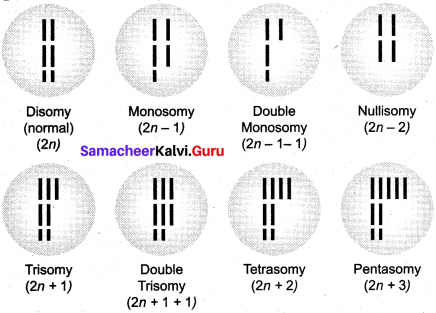
Question 25.
Mention the name of man-made cereal. How it is formed?
Answer:
Triticale, the successful first man-made cereal. Depending on the ploidy level Triticale can be divided into three main groups:
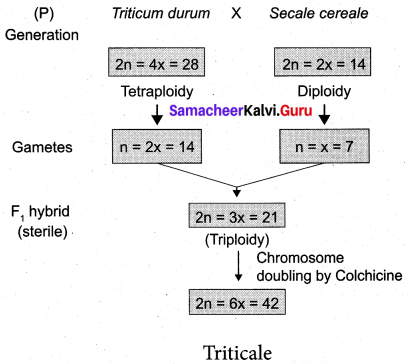
- Triticale, the successful first man-made cereal – It has 3 main groups.
Tetraploidy: Crosses between diploid wheat and rye. - Hexaploidy: Crosses between tetraploid wheat Triticum durum (macaroni wheat) and rye
- Octoploidy: Crosses between hexaploid wheat T. aestivum (bread wheat) and rye Hexaploidy Triticale hybrid plants demonstrate characteristics of both macaroni wheat and rye.
- For example, they combine the high-protein content of wheat with rye’s high content of the amino acid lysine, which is low in wheat.
![]()
Samacheer Kalvi 12th Bio Botany Chromosomal Basis of Inheritance Additional Questions and Answers
1 – Mark Questions
Question 1.
Name the scientist(s) who rediscovered the Mendelian work?
(i) Hugo de Vries
(ii) Carl Correns
(iii) Tschermak
(a) i and iv
(b) i, ii and iv
(c) (iii) i, ii and iii
(d) ii, iii and iv
Answer:
(c) i, ii and iii
Question 2.
Which is not a feature of the chromosomal theory of inheritance?
(a) Somatic cells of organisms are derived from zygote by repeated meiosis.
(b) Chromosomes retain their structural uniqueness throughout the life of an organism.
(c) Mendelian factors are located in chromosomes
(d) Sutton and Boveri independently proposed the theory.
Answer:
(a) Somatic cells of organisms are derived from zygote by repeated meiosis.
Question 3.
The following sequence represents the location of genes in a chromosome. A-B-C-M-R – S – Y – Z. Which of the gene pairs will have least chance of getting inherited together?
(a) A and M
(b) S and Y
(c) M and Z
(d) A and Y
Answer:
(d) A and Y
![]()
Question 4.
Match the column I with column II:

(a) 1 – iii, 2 – i, 3 – iv, 4 – ii
(b) 1 – ii, 2 – i, 3 – iv, 4 – iii
(c) 1 – iv, 2 – iii, 3 – ii, 4 – i
(d) 1 – ii, 2 – iii, 3 – i, 4 – iv
Answer:
(a) 1 – iii, 2 – i, 3 – iv, 4 – ii
Question 5.
Number of chromosomes (2n) in Ophioglossum is ________
(a) 1226
(b) 1622
(c) 1262
(d) 2126
Answer:
(c) 1262
Question 6.
Identify the syntenic gene from the given genes sequence of a chromosome G-H-I-J-K-L-M-A-B
(a) G and H
(b) J, K and L
(c) G and B
(d) A and B
Answer:
(c) G and B
Question 7.
Incomplete linkage was reported by Hutchinson in
(a) Drosophila
(b) Maize
(c) Neurospora
(d) Lathyrus odoratus
Answer:
(b) Maize
Question 8.
Mechanism of crossing over involves the following stages. Select the correct sequence.
(а) Tetrad stage → Synapsis → Bivalent stage → cross over
(b) Syndesis → Tetrad → Crossing over → Terminalisation
(c) Terminalisation → Tetrad → Bivalent → Cross over
(d) Cross over → Bivalent → Tetrad → Terminalisation
Answer:
(b) Syndesis → Tetrad → Cross over → Terminalisation
Question 9.
During cross over, chiasma occurs between
(a) Sister chromatids of non-homologous chromosomes
(b) Non-sister chromatids of non- homologous chromosomes
(c) Non-sister chromatids of homologous chromosomes
(d) Sister chromatids of homologous chromosomes
Answer:
(c) Non-sister chromatids of homologous chromosomes
Question 10.
The term crossing over was coined by _________
Answer:
T.H. Morgan
Question 11.
At which stage of meiosis, does the chromosomes undergo recombination process?
(a) Leptotene stage of prophase I
(b) Zygotene stage of prophase I
(c) Diplotene stage of prophase I
(d) Pachytene stage of prophase I
Answer:
(d) Pachytene stage of prophase I
Question 12.
Which of the following statement(s) is/are wrong with respect to Recombination process?
(i) Mitotic crossing over occurs rarely in somatic cells.
(ii) Syndesis refers to pairing of non-homologous chromosome.
(iii) Procentric synapsis starts from telomeres.
(iv) A Bivalent has four chromatids.
(a) i and iv
(b) ii and i
(c) ii and iii
(d) All the above
Answer:
(c) ii and iii
![]()
Question 13.
Recombination frequency (RF) is equal to
(a) \(\frac { No. of recombinants }{ No. of recombinants }\) × 100
(b) \(\frac { No. of recombinants }{ No. of patental strains }\) × 100
(c) \(\frac { No. of recombinants }{ No. of offsprings }\) × 100
(d) \(\frac { No. of recombinants }{ No. of Parental strains }\) × 100
Answer:
(c) \(\frac { No. of recombinants }{ No. of offsprings }\) × 100
Question 14.
In a population of 250 progenies produced, only 120 resemble the parental forms. Calculate the recombinant frequency.
(a) 66%
(b) 52%
(c) 59%
(d) 49%
Answer:
(b) 52%
Question 15.
The unit of distance in genetic map is called as __________
Answer:
Map unit or Centimorgan
Question 16.
The “2n” condition of Carica papaya is __________
Answer:
36
Question 17.
Mutation theory was proposed by. __________
(a) T. H. Morgan
(b) Hugo de Vries
(c) Alfred variety
(d) Erectiferm
Answer:
(b) Hugo de Vries
Question 18.
Identity the mutant variety of castor.
(a) Sharbathi Sonora variety
(b) Aruna variety
(c) Reimei variety
(d) Erectiferm variety
Answer:
(b) Aruna variety
Question 19.
Which is not a non-ionizing radiation?
(a) X-rays
(b) Gamma rays
(c) Alpha rays
(d) UV rays
Answer:
(d) UV rays
Question 20.
Transition type of gene mutation is caused when __________
(a) AC is replaced by GT
(b) AG is replaced by TC
(c) AC is replaced by TG
(d) TC is replaced by AG
Answer:
(a) AC is replaced by GT
Question 21.
Pick out the co-mutagen from the following:
(a) Eosin
(b) Mustard gas
(c) Ascorbic acid
(d) Nitrous acid
Answer:
(c) Ascorbic acid
Question 22.
Sharbati Sonara is a mutant wheat variety which is developed by irradiating the seeds with __________
(a) Thermal neutrons
(b) Gamma radiation
(c) X-rays
(d) UV radiations
Answer:
(b) Gamma radiation
![]()
Question 23.
Which one of the following ploidy is irrelevant to others?
(a) Monosomy
(b) Trisomy
(c) Tetrasomy
(d) Pentasomy
Answer:
(a) Monosomy
Question 24.
Match with correct

(a) 1 – ii, 2 – iii, 3 – iv, 4 – i
(b) 1 – ii, 2 – i, 3 – iv, 4 – iii
(c) 1 – iv, 2 – iii, 3 – ii, 4 – i
(d) 1 – ii, 2 – iii, 3 – i, 4 – iv
Answer:
(a) 1 – ii, 2 – iii, 3 – iv, 4 – i
Question 25.
Statement 1: Euploidy involves entire sets of chromosomes
Statement 2: Aneuploidy involves individual chromosomes within a diploid net.
(a) Statement 1 is correct and Statement 2 is incorrect
(b) Statement 1 is incorrect and Statement 2 is correct
(c) Both the statements are correct
(d) Both the statements are incorrect
Answer:
(c) Both the statements are correct
Question 26.
Statement 1: In transversion mutation, single purine is changed to pyrimidine.
Statement 2: In transition mutation, a purine replaced by another purine.
(a) Statement 1 is correct and Statement 2 is incorrect
(b) Statement 1 is incorrect and Statement 2 is correct
(c) Both the statements are correct
(d) Both the statements are incorrect
Answer:
(a) Statement 1 is correct and Statement 2 is incorrect
Question 27.
Statement 1: Pairing of homologous chromosome is called as syndesis.
Statement 2: Proterminal synapsis occurs from telomeres.
(a) Statement 1 is correct and Statement 2 is incorrect
(b) Statement 1 is incorrect and Statement 2 is correct
(c) Both the statements are correct
(d) Both the statements are incorrect
Answer:
(c) Both the statements are correct
Question 28.
Statement 1: The widely accepted DNA replication model is Holliday’s hybrid DNA model.
Statement 2: The vertical cut in the DNA results in heteroduplex with non-recombinants.
(a) Statement 1 is correct and Statement 2 is incorrect
(b) Statement 1 is incorrect and Statement 2 is correct
(c) Both the statements are correct
(d) Both the statements are incorrect
Answer:
(d) Both the statements are incorrect.
Question 29.
Statement 1: Self-sterility in Nicotiana is controlled by multiple alleles.
Statement 2: Multiple alleles are always responsible for the same character.
(a) Statement 1 is correct and Statement 2 is incorrect
(b) Statement 1 is incorrect and Statement 2 is correct
(c) Both the statements are correct
(d) Both the statements are incorrect
Answer:
(c) Both the statements are correct
Question 30.
Sex determination in plants was first discovered by.
Answer:
C.E. Allen
Question 31.
One of the following is not the kind of euploidy
(a) Diploidy
(b) Polyploidy
(c) Hyperploidy
(d) Autoploidy
Answer:
(c) Hyperploidy
![]()
Question 32.
The chromosomal condition 2n -2 represents __________
(a) Monosomy
(b) Nullisomy
(b) Nullisomy
(c) Trisomy
Answer:
(d) Tetrasomy
Question 33.
(a) Potato
(b) Coffee
(c) Groundnut
(d) Apple
Answer:
(d) Apple
Question 34.
Assertion (A): Polyploidy is common in plants.
Reason (R): Polyploids possess more than 2 basic sets of chromosomes.
(a) A is true R is false
(b) Both A and R are false
(c) A is true, R is not correct explanation for A
(d) R explains A
Answer:
(d) R explains A
Question 35.
Assertion (A): Complete linkage is noticed in male species of Drosophila.
Reason (R): Completely linked genes show some crossing over.
(a) A is true R is false
(b) Both A and R are false
(c) A is true, R is not correct explanation for A
(d) R explains A
Answer:
(a) A is true R is false
Question 36.
Assertion (A): Self-sterility is observed in Nicotiana species.
Reason (R): Because the genes are located on chromosome.
(a) A is true R is false
(b) Both A and R are false
(c) A is true, R is not correct explanation for A
(d) R explains A
Answer:
(c) A is true, R is not correct explanation for A
Question 37.
The first man made cereal is _______
Answer:
Triticale
Question 38.
Observe the gene sequence and identify the types of aberration A B C B C D E F?
(a) Tandem duplication
(b) Simple duplication
(c) Reverse tandem duplication
(d) Displaced tandem duplication
Answer:
(a) Tandem duplication
2 – Mark Questions
Question 1.
Write any one contribution of the following scientists to the field of molecular biology,
(a) Hugo de Vries
(b) Sutton and Boveri
Answer:
(a) Hugo de Vries proposed Mutation theory.
(b) Sutton and Boveri proposed chromosomal theory of inheritance.
Question 2.
Define Linkage. Mention its types.
Answer:
Tendency of genes to remain together during separation of chromosomes is called linkage. Linkage are of 2 types – complete linkage and incomplete linkage.
![]()
Question 3.
What does the condition synteny refers to?
Answer:
The two genes that are sufficiently far apart on the same chromosome are called unlinked genes or syntenic genes. Such condition is known as synteny.
Question 4.
What are linked genes?
Answer:
Genes located close together on the same chromosome and inherited together are called linked genes.
Question 5.
Who coined the term crossing over? When does the crossing over occurs in a cell?
Answer:
The term ‘crossing over ’ was coined by Morgan (1912). It takes place during pachytene stage of prophase I of meiosis.
Question 6.
Crossing over occurs only in germinal cells. Yes or no. Support your answer.
Answer:
No. Though crossing over is a common process in germinal cells rarely it also occurs in somatic cells during mitosis. Such crossing over is called mitotic crossing over or somatic crossing over.
Question 7.
Mention the major stages involved in crossing over.
Answer:
Crossing over is a precise process that includes stages like synapsis, tetrad formation, cross over and terminalization.
Question 8.
What are bivalents? When does this condition is noticed in a cell?
Answer:
During zygotene stage of prophase I of meiosis I, homologous chromosomes are aligned side by side resulting in a pair of homologous chromosomes called bivalents.
Question 9.
What is meant by synaptonemal complex?
Answer:
Synaptonemal complex is a highly organised structure or filaments that facilitates the synapsis and chiasma formation during crossing over mechanism.
Question 10.
What will be the result if there is a failure in the formation of synaptonemal complex. Give one example of organism where such condition is noticed?
Answer:
Failure in the formation of synaptonemal complex leads to the absence of crossing over to take place. It is noticed in certain male species of Drosophila.
Question 11.
Define terminalization.
Answer:
After crossing over, chiasma starts to move towards the terminal end of chromatids. This is known as terminalization. As a result, complete separation of homologous chromosomes occurs.
Question 12.
Write the formula to calculate recombination frequency.
Answer:
\(\frac { No. of recombinants }{ No. of offsprings }\) × 100
Question 13.
What is genetic mapping?
Answer:
The diagrammatic representation of position of genes and related distances between the adjacent genes is called genetic mapping. It is directly proportional to the frequency of recombination between them. It is also called as linkage map.
Question 14.
Define the terms
(a) locus
(b) centimorgan.
Answer:
(a) Locus: A specific location of genes on a chromosome.
(b) Centimorgan: Unit of distance in a genetic map.
Question 15.
What are multiple alleles?
Answer:
When any of the three or more allelic forms of a gene occupy the same locus in a given pair of homologous chromosomes, they are said to be called multiple alleles.
Question 16.
Does environment determines the sex of a plant? Explain in brief with an example.
Answer:
Yes, the equisetum (horsetail plant), which grow under good conditions develop as female plants those grown under stressed condition develops as male then supporting the fact environment can also determines the sex of plant in few species.
Question 17.
Why do we call papaya a dimorphic plant.
Answer:
Papaya is a dimorphic plant since their sexes are separate i.e., male plant produces flowers with stamens and female plants produces flowers with carpels.
Question 18.
Define the term mutation. Who coined the term?
Answer:
A sudden change in the genetic material of an organisms is called mutation. The term mutation was introduced by Hugo de Vries.
![]()
Question 19.
Compare point mutation with chromosomal mutation.
Answer:
Mutational events that take place within individual genes are called gene mutations or point mutation, whereas the changes occur in structure and number of chromosomes is called chromosomal mutation.
Question 20.
Based on the effect on translation, classify mutations.
Answer:
(a) Silent mutation
(b) Mis-sense mutation
(c) Non-sense mutation
(d) Frameshift mutation
Question 21.
What does indel mutation refers to?
Answer:
Addition or deletion mutations are actually additions or deletions of nucleotide pairs and also called base pair addition or deletions. Collectively, they are termed as indel mutations.
Question 22.
Define mutagens and mention its types.
Answer:
The factors which cause genetic mutation are called mutagenic agents or mutagens. Mutagens are of two types, physical mutagen and chemical mutagen.
Question 23.
Point out any four physical mutagens.
Answer:
Temperature, X-rays, Gamma rays and UV rays.
Question 24.
Write a brief note on Castor Aruna variety.
Answer:
Castor Aruna is mutant variety of castor which is developed by treatment of seeds with thermal neutrons in order to induce very early maturity (120 days instead of 270 days as original variety).
Question 25.
How Sharbati Sonora was developed by Dr. M.S. Swaminathan etal?
Answer:
Sharbati Sonora is a mutant variety of wheat, which is developed from Mexican variety (Sonora 64) by irradiating of gamma rays.
Question 26.
Name any four chemical mutagens.
Answer:
(a) Ethyl methane sulphonate (EMS)
(b) Mustard gas
(c) Magnous salt
(d) Formaldehyde
Question 27.
Nitrous oxide is a potent mutagen – comment.
Answer:
Nitrous oxide alters the nitrogen bases of DNA and disturb the replication and transcription that leads to die formation of incomplete and defective polypeptide during translation.
Question 28.
What is ploidy?
Answer:
The chromosome number of somatic cells changes due to addition or elimination of individual chromosome or basic set of chromosomes. This condition in known as numerical chromosomal aberration or ploidy.
Question 29.
Differentiate Aneuploidy from Euploidy.
Answer:
Aneuploidy:
- Ploidy involving individual chromosomes within a diploid set.
- E.g: Trisomy.
Euploidy:
- Ploidy involving entire sets of chromosomes.
- E.g: Polyploidy.
Question 30.
Comment on the chromosomal condition; 2n – 2.
Answer:
Loss of pair of homologous chromosome from the diploid set is called Nullisomy. Selling of monosomic plants produces Nullisomics. They are generally lethal.
Question 31.
Name any 3 auto tetraploids and one natural autotriploid plant species.
Answer:
(a) Autotetraploids : Rye, potato and coffee.
(b) Natural autotriploid : Cyanodon dactylon (common doob grass).
![]()
Question 32.
What are deficiency loops?
Answer:
Deletions are observable during meiotic pachytene stage and polytene chromosome. The unpaired loop formed in the normal chromosomal part at the time of chromosomal pairing. Such loops are called as deficiency loops and it can be seen in meiotic prophase.
Question 33.
Given below are the gene sequences on the chromosome. Compare them with the normal chromosome and identify the type of structural chromosomal aberrations.
Normal Chromosome: A-B-C-D-E-F-G-H-I.
Chromosome 1 : A-B-C-B-C-D-E-F-G-H-I.
Chromosome 2 : A-B-C-D-F-G-H-I
Answer:
Chromosome 1 : Tandem duplication.
Chromosome 2 : Intercalary deletion.
3 – Mark Questions
Question 34.
Point out any three salient features of the chromosomal theory of inheritance.
Answer:
Salient features of the chromosomal theory of inheritance:
- Somatic cells of organisms are derived from die zygote by repeated cell division (mitosis). These consist of two identical sets of chromosomes. One set is received from female parent (maternal) and the other from a male parent (paternal). These two chromosomes constitute the homologous pair.
- Chromosomes retain their structural uniqueness and individuality throughout the life cycle of an organism.
- Each chromosome carries specific determiners or Mendelian factors which are now termed as genes.
Question 35.
Compare Mendelian factors with chromosome
Answer:
Mendelian factors:
- Alleles of a factor occur in pair.
- Similar or dissimilar alleles of a factor separate during the gamete formation.
- Mendelian factors can assort independently.
Chromosomes behaviour:
- Chromosomes occur in pairs.
- The homologous chromosomes separate during meiosis.
- The paired chromosomes can separate independently during meiosis but the linked genes in the same chromosome normally do not assort independently.
Question 36.
State Coupling and Repulsion theory.
Answer:
The two dominant alleles or recessive alleles occur in the same homologous chromosomes, tend to inherit together into same gamete are called coupling or configuration. If dominant or recessive alleles are present on two different, but homologous chromosomes they inherit apart into different gamete are called repulsion or trans configuration.
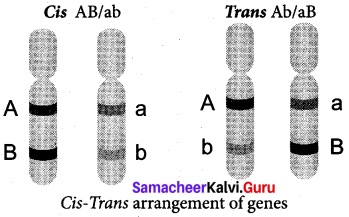
Question 37.
Give a short note on incomplete linkage.
Answer:
If two linked genes are sufficiently apart, the chances of their separation are possible. As a result, parental and non-parental combinations are observed. The linked genes exhibit some crossing over. This phenomenon is called incomplete linkage. This was observed in maize. It was reported by Hutchinson.
Question 38.
How crossing over differs from linkage?
Answer:
Linkage:
- The genes present on chromosome stay close together.
- It involves same chromosome of homologous chromosome.
- It reduces new gene combinations.
Crossing over:
- It leads to separation of linked genes.
- It involves exchange of segments between non-sister chromatids of homologous chromosome.
- It increases variability by forming new gene combinations. Leading to formation of new organism.
![]()
Question 39.
What is Synapsis? Explain its types.
Answer:
Pairing of homologous chromosomes during the zygotene stage of prophase I of meiosis I is called synapsis. Synapsis is of three types:
- Procentric synapsis: Pairing starts from the middle of the chromosome.
- Proterminal synapsis: Pairing starts from the telomeres.
- Random synapsis: Pairing may start from anywhere.
Question 40.
How and where chiasma is formed?
Answer:
After tetrad formation, crossing over occurs in the pachytene stage. The non-sister chromatids of the homologous pair make a contact at one or more points. These points of contact between non-sister chromatids of homologous chromosomes are called Chiasmata (singular-Chiasma). At chiasma, cross-shaped or X-shaped structures are formed, where breaking and rejoining of two chromatids occur. This results in reciprocal exchange of equal and corresponding segments between them.
Question 41.
Classify cross over.
Answer:
- Single cross over: Formation of single chiasma and involves only two chromatids out of four.
- Double cross over: Formation of two chiasmata and involves two or three or all four strands.
- Multiple cross over: Formation of more than two chiasmata and crossing over frequency is extremely low.
Question 42.
What is recombination? Which is the widely accepted model of DNA recombination?
Answer:
Crossing over results in the formation of new combination of characters in an organism called recombinants. In this, segments of DNA are broken and recombined to produce new combinations of alleles. This process is called recombination.
The widely accepted model of DNA recombination during crossing over is Holliday’s hybrid DNA model.
Question 43.
Which type of testcross provides the data to construct an efficient genetic map? Explain.
Answer:
A more efficient mapping technique is to construct based on the results of the three-point test cross. It refers to analyzing the inheritance patterns of three alleles by test crossing a triple recessive heterozygote with a triple recessive homozygote. It enables to determine the distance between the three alleles and the order in which they are located on the chromosome. Double cross overs can be detected which will provide more accurate map distances.
Question 44.
Enumerate the uses of Genetic mapping.
Answer:
- It is used to determine gene order, identify the locus of a gene and calculate the distances between genes.
- They are useful in predicting results of dihybrid and trihybrid crosses.
- It allows the geneticists to understand the overall genetic complexity of particular organism.
Question 45.
List any three characteristic features of multiple allele.
Answer:
- Multiple alleles of a series always occupy the same locus in the homologous chromosome. Therefore, no crossing over occurs within the alleles of a series.
- Multiple alleles are always responsible for the same character.
- The wild-type alleles of a series exhibit dominant character whereas mutant type will influence dominance or an intermediate phenotypic effect.
Question 46.
Explain the sex determination mechanism in Carica papaya.
Answer:
Carica papaya, 2n=36 (Papaya) has 17 pairs of autosomes and one pair of sex chromosomes. Male papaya plants have XY and female plants have XX. Unlike human sex chromosomes, papaya sex chromosomes look like autosomes and it is evolved from autosome. The sex chromosomes are functionally distinct because the Y chromosome carries the genes for male organ development and X bears the female organ developmental genes. In papaya, sex determination is controlled by three alleles. They are m, Mj, and M2 of a single gene.
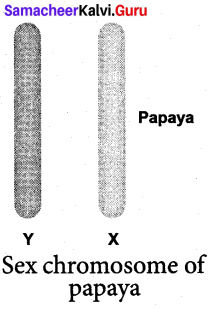
Sex chromosome of papaya

Question 47.
Differentiate Mis-sense mutation from Non-sense mutation.
Answer:
Mis-sense Mutation:
The mutation where the codon for one amino acid is changed into a codon for another amino acid is called Mis-sense or non-synonymous mutations.
Non-sense Mutation:
The mutations where the codon for one amino acid is changed into a termination or stop codon is called Non-sense mutation.
Question 48.
What is a frameshift mutation?
Answer:
Mutations that result in the addition or deletion of a single base pair of DNA that changes the reading frame for the translation process as a result of which there is a complete loss of normal protein structure and function are called Frameshift mutations.
![]()
Question 49.
How temperature induces mutation?
Answer:
Increase in temperature increases the rate of mutation. While rise in temperature breaks the hydrogen bonds between two DNA nucleotides which affects the process of replication and transcription.
Question 50.
Explain co-mutagens with examples.
Answer:
The compounds which are not having own mutagenic properties but can enhance the effects of known mutagens are called co-mutagens.
Example: Ascorbic acid increases the damage caused by hydrogen peroxide. Caffeine increases the toxicity of methotrexate.
Question 51.
Name the following chromosomal conditions.
(a) 2n + 2 + 2
(b) 2n – 1 – 1
(c) x
(e) 2n + n + n
(f) 2n + 1
Answer:
(a) Double tetrasomy
(b) Double monosomy
(c) Monoploidy
(e) Polyploidy
(f) Trisomy
Question 52.
Give an account on colchicine.
Answer:
Colchicine, an alkaloid is extracted from the root and conns of Colchicum autumnale, when applied in low concentration to the growing tips of the plants it will induce polyploidy. Surprisingly it does not affect the source plant Colchicum, due to the presence of anticolchicine.
Question 53.
Explain the three types of duplication with a diagram.
Answer:
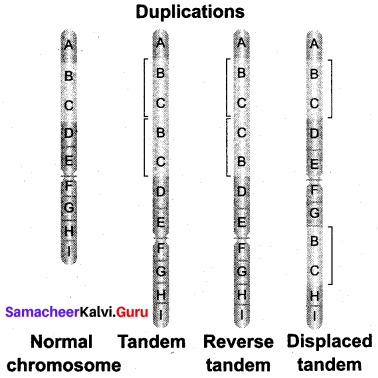
- Tandem duplication: The duplicated segment is located immediately after the normal segment of the chromosome in the same order.
- Reverse tandem duplication The duplicated segment is located immediately after the normal segment but the gene sequence order will be reversed.
- Displaced duplication: The duplicated segment is located in the same chromosome, but away from the normal segment.
5 – Mark Questions
Question 54.
Why crossing over is important?
Answer:
- The exchange of segments leads to new gene combinations which play an important role in evolution.
- Studies of crossing over reveal that genes are arranged linearly on the chromosomes.
- Genetic maps are made based on the frequency of crossing over.
- Crossing over helps to understand the nature and mechanism of gene action.
- If a useful new combination is formed it can be used in plant breeding.
Question 55.
Draw a flow chart depicting the various types of ploidy.
Answer:
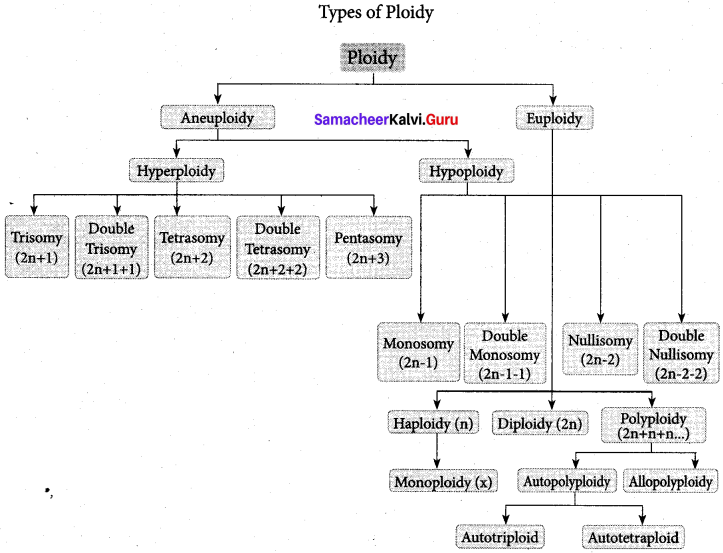
Question 56.
Explain hyperdiploid with its types.
Answer:
Hyperploidy
Addition of one or more chromosomes to diploid sets are called hyperploidy. Diploid set of chromosomes represented as Disomy. Hyperploidy can be divided into three types. They are as follows:
(a) Trisomy: Addition of single chromosome to diploid set is called Simple trisomy (2n+l). Trisomics were first reported by Blackeslee (1910) in Datura stramonium (Jimson weed). But later it was reported in Nicotiana, Pisum and Oenothera. Sometimes addition of two individual chromosome from different chromosomal pairs to normal diploid sets are called Double trisomy (2n+l+l).
(b) Tetrasomy: Addition of a pair or two individual pairs of chromosomes to diploid set is called tetrasomy (2n+2) and Double tetrasomy (2n+2+2) respectively. All possible tetrasomics are available in Wheat.
(c) Pentasomy: Addition of three individual chromosomes from different chromosomal pairs to normal diploid set are called pentasomy (2n+3).
![]()
Question 57.
List out the significance of ploidy.
Answer:
- Many polyploids are more vigorous and more adaptable than diploids.
- Many ornamental plants are autotetraploids and have larger flowers and longer flowering duration than diploids.
- Autopolyploids usually have increase in fresh weight due to more water content.
- Aneuploids are useful to determine the phenotypic effects of loss or gain of different chromosomes.
Question 58.
Explain the Translocation type of chromosomal aberration. Translocation
Answer:
The transfer of a segment of the chromosome to a non-homologous chromosome is called translocation. Translocation should not be confused with crossing over, in which an exchange of genetic material between homologous chromosomes takes place. Translocation occurs as a result of the interchange of chromosome segments in non-homologous chromosomes.
There are three types:
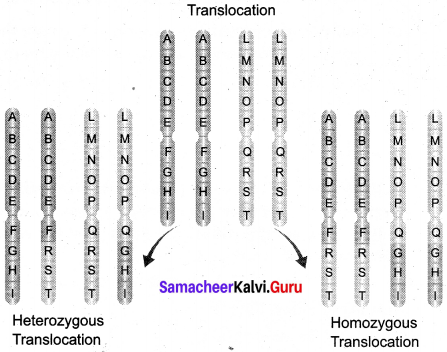
- Simple translocation
- Shift translocation
- Reciprocal translocation
i. Simple translocation: A single break is made in only one chromosome. The broken segment gets attached to one end of a non-homologous chromosome. It occurs very rarely in nature.
ii. Shift translocation: A broken segment of one chromosome gets inserted interstitially in a non-homologous chromosome.
iii. Reciprocal translocations: It involves the mutual exchange of chromosomal segments between two non-homologous chromosomes. It is also called illegitimate crossing over. It is further divided into two types.
a. Homozygous translocation: Both the chromosomes of two pairs are involved in translocation. Two homologous of each translocated chromosomes are identical.
b. Heterozygous translocation: Only one of the chromosome from each pair of two homologous are involved in translocation, while the remaining chromosome is normal. Translocations play a major role in the formation of species.
Higher-Order Thinking (HOTs) Questions
Question 1.
Given below is a sequence of alphabets representing the genes of the chromosome. Observe it and answer the questions.
A-B-C-D-E-F-G-H-I-J-K.
(a) Write the sequence of genes after the chromosome undergoes terminal deletion of a single gene.
(b) What will be the gene sequence, if the genes E and F undergo tandem duplication?
(c) Consider the centromere is located between the genes F and G and write a gene sequence after paracentric inversion occurs in between the genes C, D, and E.
Answer:
(a) B – C – D – E – F – G – H -I – J – K (or) A- B – C – D – E – F – G – H -I – J.
(b) A – B – C – D – E – F – E – F – G – H – I – J – K.
(c) A – B – E – D – C – F – G – H -1 – J – K.
![]()
Question 2.
In Drosophila melanogaster, there are four pairs of chromosomes. If there occur chromosomal aberrations resulting in trisomic and monosomic conditions, what will be the chromosomal count? Write the correct chromosomal count against respective chromosomal aberration.
Answer:
Normal chromosome of Drosophila melanogaster (2n) = 8
Frisomic condition (2n+1) = 9
Monosomic condition (2n – 1) = 7
Question 3.
Study the figures given below and answer the questions.
Answer:
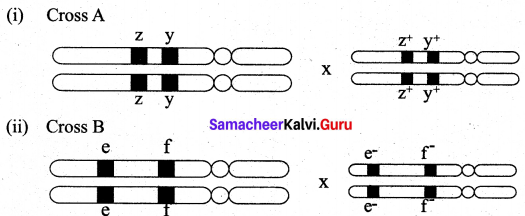
Which type of cross produces higher recombinant percentage? Give reason in support of your answer.
(a) Cross B produces more recombinants.
(b) The gene e and f are located sufficiently apart leading to crossing over resulting in recombinant varieties.